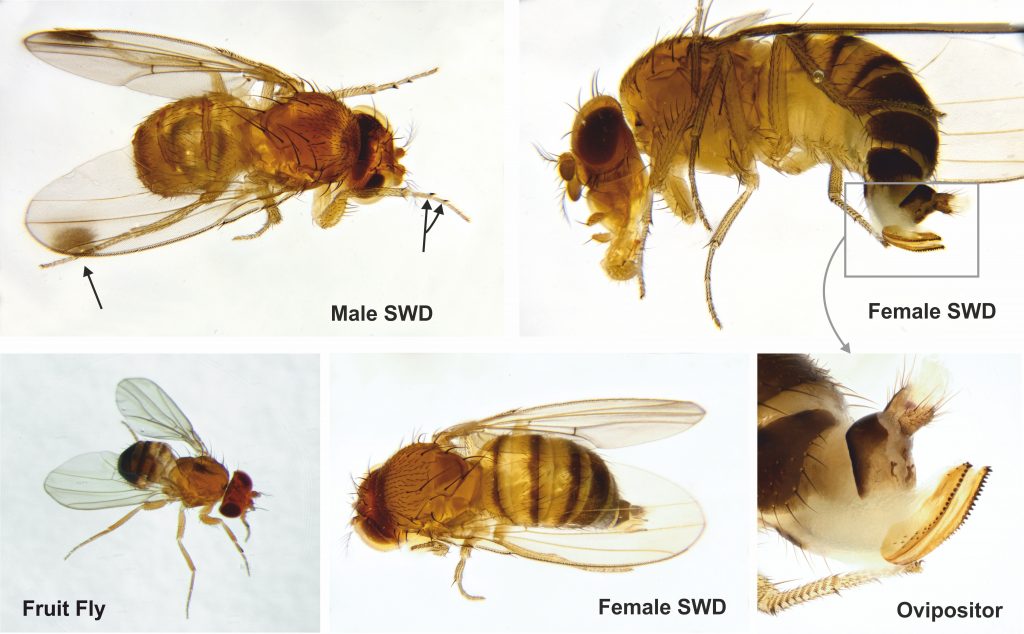Spotted Wing Drosophila survey experiment 2021


I’m Chris Thomas, a member of the Quekett Microscopical Club. We are promoting this survey because it is a simple, very practical and relevant use of microscopy, open to all.
The 2021 Quekett’s Spotted Wing Drosophila survey experiment is a citizen science project open to all. It suits individuals, schools and researchers, with or without a low power microscope.
A reminder. Spotted Wing Drosophila is a fruit fly achieving global devastation of soft and stone fruits. The males are easily identified by eye due to the characteristic wing spot, with a hand lens or even on an enlarged photo. The females do not have the wing spot but do have a vicious-looking serrated ovipositor (egg laying organ), which is best seen under a low power stereomicroscope or by some other means of magnification greater than 15×. It is very easy to set up traps that mainly catch fruit flies. Counting and scoring results from traps really becomes useful when linked to results collected by others. We can learn a lot more about the biology of the pest if many people contribute.
We would like you to use a Fruit Fly trap to catch SWD over a week, count what you have caught and send the results to Chris Thomas at [email protected]
The aim is to collate all the results and publsh them in the Quekett Journal, mentioning all participants, as was done previously for the 2016 survey.
A simple A4 sheet summarising the experiment can be found here https://bit.ly/2021-PDF-SWD-Survey
What to do
You will need:
- A large empty clear plastic bottle
- Apple cider vinegar (cheapest from supermarket)
- Washing-up liquid
- Some string
- A large nail or auger (2 mm to 3 mm diameter)
- A magnifying glass OR a low power stereo microscope
- CAREFULLY pierce 8 holes in the bottle more than half way up the bottle. Adults – please supervise children for this step. To avoid injury, I recommend doing this on a table or a board, lie the bottle down, hold it firmly at the bottom half and gently pierce with a sharp metal point or augur down, through the upper side of the bottle towards the board. (If the point slips, it should go safely into the table or board and NOT into your hand.) The holes need to be 2 mm to 3 mm in diameter, to let in small flies. I used a sharp augur to pierce the plastic and then a wider diameter nail to enlarge the hole. Watch the video at https://youtu.be/cib12l8LSuw
- Fill the upright bottle to ¼ to ⅓ with apple cider vinegar. The level must be below the holes!
- Add one or two drops of washing-up liquid
- Screw lid back onto plastic bottle
- Use the string to hang your baited trap from a tree/bush/holder at a suitable place.
- Leave the trap for one week.
- At the end of the week, seal up holes with sellotape.
- Swirl bottle gently and carefully pour the fly catch into a white /light coloured plastic dish. (OPTIONAL – I strain the fly catch through an old metal tea sieve and then transfer the flies to clean water. with a bit of vinegar and alcohol in it to preserve them.)
- Record your results (see below)
- at the end of the experiment, bleach and flush away the flies and liquid. Rinse and dispose of the plastic bottle in an environmentally friendly way
Identification help
- Either use a magnifying glass or a low power microscope to magnify the catch.
- You can also take a close-up picture with a smartphone or camera on macro setting and then magnify the catch by zooming in on the picture on a PC or tablet screen. I’d love to see your pictures too, so add them to any observation.
- Fruit flies are very small, between 2 mm and 5 mm long. They are quite distinctive.
- To identify SWD, use the project banner pictures to help you.
- Male SWD are obvious even to the naked eye – they are red eyed fruit flies with a black spot at the end of the wing. under magnification they also have 2 spurs on their forelegs
- Female SWD are best viewed under 10× to 30× magnification – where their vicious saw like ovipositor (egg-laying organ) can be seen clearly. Once you have seen one, you will never be confused. They also have clear black and yellow bands on their abdomen.
RECORD RESULTS BELOW AND SEND TO US
- Name and address (or just your post code)
- Date the fly trap emptied
- Total number of ALL insects/creatures in trap
- Total number of ALL fruit flies
- Number of male Spotted Wing Drosophila
- Number of female Spotted Wing Drosophila (microscope users only)
- SEND RESULTS TO Chris Thomas at [email protected]
Discarding waste at the end of the experiment
Bleach and flush away the flies and used trap liquid, and wash your hands.
Note:
- Record ALL results – even if you did not catch anything. (You can enter Nothing as an observation name in the first box ‘What did you see?’ if you did not catch anything).
- If I see no Spotted Wing Drosophila, but fruit flies are present, I enter ‘Common Fruit Fly’
Have you got this far!?! Great! Go out and make a trap and I’ll look forward to your results.
Chris Thomas. Quekett Bulletin Editor, [email protected]

